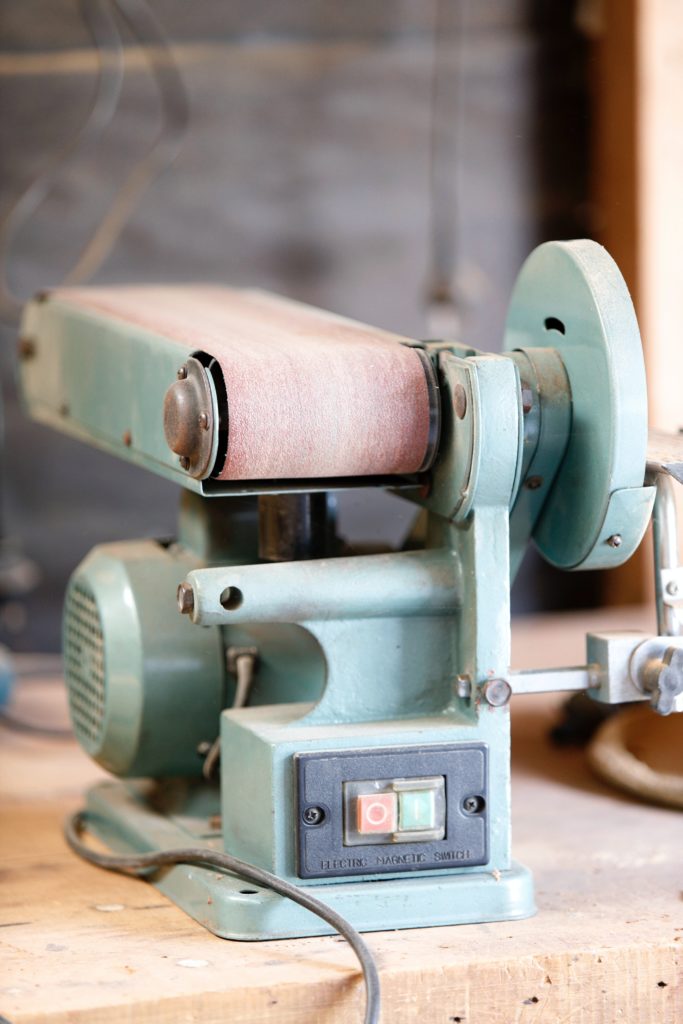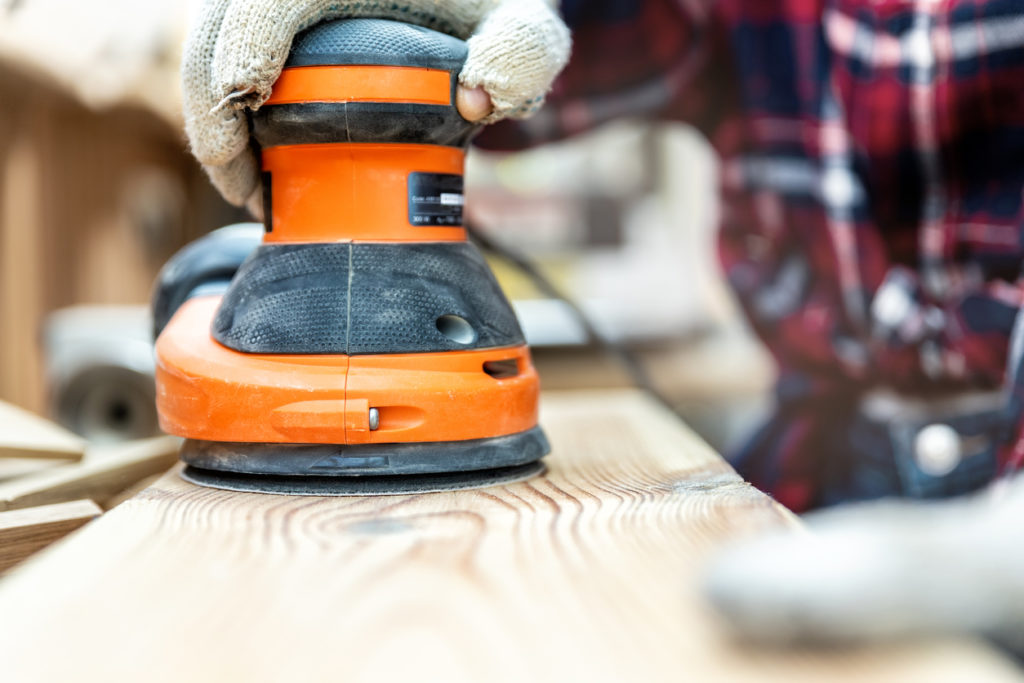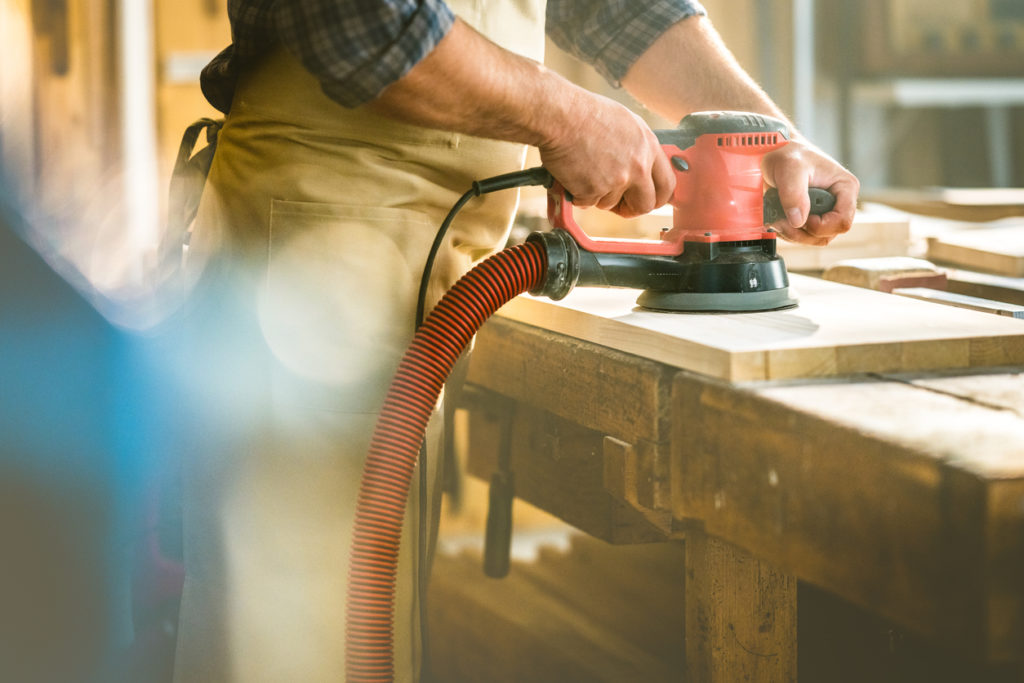Wooden furniture creates a cozy, authentic feel in a room, but unfortunately, wooden pieces tend to fade and lose their gleam over time. Luckily, it’s easy to refinish your old wooden furniture to bring back its original look. You start by sanding the wood to remove old paint or varnish, creating a smooth surface to apply new paint. Sanding with sandpaper is tedious, and power sanders are a perfect alternative. There are different types of sanders that work best for specific projects. Here is a comprehensive guide to help you pick the best sander for the furniture you’re working on.
An Overview of Wood Sanding
Sanding involves abrading wood fibers to smoothen and flatten a surface. It helps remove splinters and straighten out uneven surfaces. Sanding also removes milling marks and scratches to bring out the natural beauty of the wood.
Hand sanding works well for small, intricate projects where an electric sander could cause damage. Sanding wood furniture by hand gives you more control over the surface and makes it easier to smooth edges and recesses that could be hard to reach by machine. However, hand sanding requires more time and effort to finish a project and causes muscle fatigue. You will also need to use multiple sandpaper sheets for a single project.
Fortunately, power sanders make even bigger projects quicker and easier. You can use a power sander for furniture, cabinet making, toy manufacturing, and staircase building.
Types of Sanders
Every professional or hobbyist woodworker needs to have an assortment of power sanders for different applications. Here are the types to consider.
Belt Sander

A belt sander is a heavy-duty tool perfect for stripping paints and finish on tables and dressers. It uses abrasive sandpaper stretched over a continuous loop belt. The motor moves the belt around wheels at high speed to remove large amounts of materials on wood surfaces within a short time.
This option differs from other types in that it moves the sanding belt rather than vibrating, which is very beneficial while sanding rough areas. A belt sander is best suited for rough finish removal or planning down horizontal surfaces like table tops.
Belt sanders come in different sizes. While the biggest ones will give you better coverage, they are difficult to navigate around corners. Smaller belt sanders are also more portable. You can find this option in battery and electric-powered versions.
- 7-amp motor rotates the belt at over 13 feet per second
- Compact design weighs in at a mere six pounds to limit the fatigue of the user
- Includes a detachable dust bag to minimize clean-up
- Lock-in safety feature allows for continuous sanding without requiring a constant grip on the trigger
- Backed by a two-year warranty and a nationwide network of skilled technicians
Random Orbital Sander

A random orbital sander is the best type for furniture if you are looking for a versatile option. It has a round sanding pad that vibrates and spins in random orbits. The random movements don’t leave swirl patterns on the wood surface. With this sander, you will get a balance between heavy-duty and smooth sanding on delicate surfaces. This is another great option for sanding large areas like cabinet surfaces and thicker ones like furniture legs. Consider an orbital sander if you want to buy just one tool for most of your sanding projects.
- POWERFUL - With a 2.8 amp motor and 13,000 orbits per minute, it's able to deliver a smooth performance over a variety of sanding applications.
- EASY TO CLEAN DUST CONTAINER - The X-flow dust collector uses cyclone force to collect dust in it's easy-to-empty transparent container.
- SPEED CONTROL - Variable speed control provides the right amount of power and control across different materials.
- LOW VIBRATION - Through its ergonomic design and a soft rubber grip your hand stays comfortable while counterweight balance reduces hand fatigue from vibration. All so that you can work longer.
- SAND IN TIGHT PLACES - With a compact size and ergonomic design This sander can get into tight spaces easily and maximizes user control.
Disc Sander
Disc sanders are also very popular since they can handle multiple projects. This option has a distinctive disc-shaped surface that gives the wood a unique look. Disc sanders work well on rough surfaces where you need to scrape a lot of material. It provides a middle ground between being gentle and offering enough power to cover large surfaces.
This tool can also get into narrow spaces where a belt sander can’t. You can control smaller disc sanders with a single hand, but larger ones require both hands to operate. There are both corded and battery-powered versions.
- Two-in-one sanding machine includes both a 4-by-36 inch belt and a 6-by-6 inch disc
- Belt tilts anywhere from 0 to 90 degrees
- Sturdy cast iron base prevents any heavy vibrations
- 4.3 Amp motor provides up to 3600 RPM
- Tension release lever provides for simple changes between sandpaper grits
Orbital Finishing Sander
You need a finish sander to achieve a highly polished look on intricate furniture. It works in circular orbital motions, perfect for stripping off the dry varnish, removing old wood putty, and rounding sharp edges. This is a lightweight, easy-to-use tool, ideal for all skill levels.
You can use orbital sanders when beginning woodwork projects like designing a table, birdhouse, or window boxes. The sander has changeable pads at the base that are easy to replace. One advantage of this option is that the sanding pads are easier and cheaper to replace than the sander belt. An orbital sander also has few vibrations, making it easier to control.
- The Bosch GSS20-40 Orbital Finishing Sander was engineered for sanding surfaces with very tight orbital motions. It is driven by an advanced high speed electrical motor with a powerful capacity of 2.0 amps and 12,000 oscillations per minute.
- This orbital sander, also known as a palm sander, includes a precision-machined aluminum sanding plate developed for even sanding and long-lasting durability that will add the perfect finishing touch to all of your woodworking projects.
- The GSS20-40 features a dust collection system that provides a micro-filter dust canister with a screw-off cap. This efficient system optimizes dust collection by extracting all dust through the pad--ranging from coarse to fine particles.
- The soft-grip was designed with a functional focus. This ensures low-vibration and provides stable handling for secure user control. The ergonomics of the sander enhances comfort for the user and long-term applications.
- The sander provides a reliable clamping and pad design that accepts multiple sanding sheets including stick-on paper. The sander offers flush sanding, which provides the user with a different array of applications for all project needs.
Detail Sander
The detail sander is a triangular orbital sander with a pointy shape designed to sand narrow spaces and contoured surfaces. Some even have attachments to allow for precise sanding in hard-to-reach areas. However, this type of sander is usually smaller and not designed to work on large surfaces with lots of material to rip off.
- POWERFUL - With a 1. 2 amp motor and 13,500 orbits per minute, it's able to deliver a smooth performance over a variety of sanding applications.
- VERSATILITY ON THE QUICK - This 4-in-1 detail sander comes with an additional 3 detail attachments for fine finishing large surfaces corners/edges and any surface contour. These attachments are easy to change with no tool needed.
- TOUGH ON DUST - Between its micro-filtration system and the 1-1/4" dust port for vacuum attachment you can choose your preferred way to keep dust away.
- EASY SANDING SHEET CHANGE - Hook and loop system for simple and quick sanding sheet changes.
- LOW VIBRATION - Ergonomic design and a soft rubber grip your hand stays comfortable while counterweight balance reduces hand fatigue from vibration. All so that you can work longer.
Stationary Sander
This floor or table-mounted sander contains a spinning sanding disk and a rotating belt. A stationary sander works well in woodwork sanding that requires high precision, like fine fretwork.
- Two-in-one sanding machine includes both a 4-by-36 inch belt and a 6-by-6 inch disc
- Belt tilts anywhere from 0 to 90 degrees
- Sturdy cast iron base prevents any heavy vibrations
- 4.3 Amp motor provides up to 3600 RPM
- Tension release lever provides for simple changes between sandpaper grits
Choosing the Right Sander for Your Project
A hobbyist or novice woodworker should acquire a multipurpose tool like the random orbital sander to manage various tasks. A random orbital sander perfectly removes paints on surfaces and is also ideal for sanding drywall and baseboards. Buy the best orbital sander you can find if you want to repair a deck. Most decks are made from softwood, so avoid sanders that can gouge the material.
The orbital finishing sander is your best fit for wood finishing. Most types allow you to switch from gritty sandpaper that removes huge amounts of wood grains on a surface to fine discs that give you a smooth finish.
If you want to work on a wooden fence, your choice will depend on the fence location and wood type. Use the portable sanders for smaller fences, but choose a cordless design with a long-lasting battery for bigger fence projects. The detail sander will allow you to get to the little corners easily.
Use belt sanders for wooden floors. The belt sander also makes good sense for any homeowner since you will need it to occasionally refinish your tables and wooden counters. Those who regularly handle high-precision woodwork projects will need a stationary sander.
Things To Consider When Buying a Sander
With so many power sanders in the market today, it’s easy to find the one that meets your needs. Whichever type you prefer, keep the following factors in mind.
Convenience
Comfort and grip are essential features when buying any power tool. Choose a sander with a padded grip to keep your hands comfortable as you work. When buying sanders online, check for reviews like a comfortable handle. Opt for a stable sander that doesn’t shake, vibrate or move around while in use. Choose a tool with a balanced weight to prevent straining your hands.
Unit Power
The main power sources used in sanders are electricity and battery. Opt for corded sanders if you work predominantly at one spot with access to a power outlet. Check the amperage rating to determine the corded sander’s exact power. On the other hand, opt for cordless sanders if you need to move around. Some models hold batteries for a long time and have a rapid charge system. Check the voltage to know the maximum battery potential. Consider also the battery-powered sander’s run time. This is how long the tool can operate on a full battery.
Dust Collection
Sanders generates more dust than any other power tool, so buy one that has a dust collection system. Some have a canister, dust bags, or dust shrouds connecting to vacuums to remove debris.
Speed
Check the sander’s speed indicated in either rotations, feet, orbits, or oscillation times per minute, depending on the type of tool. The higher the speed, the less time is needed to work on a surface. Choose a sander with a variable speed function to give you control on different surfaces.
Safety Features
Buy a sander with a trigger lock system to keep the tool turned on without continuously holding the trigger. This allows you to concentrate on the job to prevent accidents. It should also have a vibration dampening pad to prevent harming your ears. Choose a sander with an emergency stop system that instantly brakes to prevent injuries.
Cost
Pick a great sander within your budget with the right features to accomplish your tasks. Consider also the sandpaper cost. Ceramic sandpapers can be expensive, especially if you use many. There are several more affordable options. Keep in mind that some sanders require a specific type of sandpaper.
Sanding Pad Size
Pick the right sandpaper size based on the type of sander and the sanding pad size. Remember that random orbit and palm sanders use circular sanding discs, belt sanders require sanding belts, and detail sanders need custom triangular-shaped sanding pads.
How To Safely Use Sanders
Power sanders can cause injuries when misused. To make sure you’re using your tool correctly, read the user manual thoroughly. Pay attention to any instructions on application, setup, and limitations. Always wear safety goggles or a face shield to protect your eyes from dust when operating a sander. Depending on the tool’s noise level, you may also need hearing protection. Put on protective footwear and gloves to protect yourself from flying wood. Sanding produces lots of dust, so you need a dust mask.
Keep your hands off the abrasive surfaces, and protect your hair or clothing from coming into contact with the moving parts of the tool. Disconnect the sander from power when installing sanding material or cleaning it. Avoid sanding thin handheld wooden surfaces.
Power Sander Maintenance Tips
The only way to ensure that your power sander works right is by taking good care of it. After a job, remove the covers and blow off any dust that could have accumulated underneath. Clean the sander thoroughly, focusing on the fan system, chambers, tubes, conveyor, and motor. Perform regular inspections on the sander to ensure that every part is in perfect working condition. Check the brushes, plug ends, and cords regularly for damage. Inspect the sand pads and wheels before starting any task for damage or debris that could scratch the wood surface.
Replace any rough or damaged belts to prevent straining the motor, which affects the sander’s overall longevity. Leaving sandpaper on a tool for too long can damage your work surface or the machine. Change the sandpaper if projects start to take a bit longer or if you notice uneven sanding.
Check the screws for loosening and fasten them appropriately. Also, measure your electrical outlet’s voltage using a voltmeter before plugging in a sander. Too much current than required can damage the tool’s electrical components. Pay attention to your machine while in operation to see if you notice any unusual sounds. Thumping sounds and squealing noise mean that the sander needs repairs. You can correct minor issues by seeking immediate repairs before they become significant problems. Leave repair tasks to a certified technician so that you don’t void the warranty.
Refer to the manufacturer’s manual to guide you on the right type and amount of lubrication required for your specific sander. Have a professional service your tool at the recommended intervals. You can use the sander as often as needed, but avoid overusing it. Practices like running the tool for too long and using too much force can cause unnecessary wear and tear, leading to a premature breakdown. Store your sander in a cool, dry place when not in use.
Bottom Line
Investing in the right sander will pay off in terms of consistent results, perfect finishes, and ease of work. A good sander can take your woodwork projects to the next level regardless of your skills. Although all sanders perform the same task, knowing the differences will help you pick the right type for your particular project.





